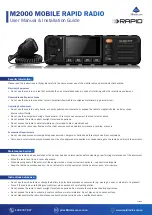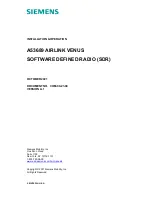
Model RG1 Owner’s Manual
Page 9
www.midlandradio.com
Installation
Installation
The REGATTA 1 will only operate with a nominal 13.8 volt negative ground bat-
tery system. It is important to carefully determine the most suitable location for your
radio on your vessel. Electrical, mechanical, and environmental considerations must all
be taken into account. You should select the optimum relationship among these consid-
erations.
Features which should be considered are:
1. The universal mounting bracket may be installed on either the top or bottom
of a shelf, on a bulkhead, or for overhead mounting.
2. The accessory speaker wires can be used with an external speaker.
3. All connections are "plug-in" type for easy removal of the radio.
4. Front fire built-in speaker allows for convenient in-dash mounting.
Choosing a Location
Some important factors to consider in selecting the location for your REGATTA 1.
1. Select a location that is free from spray and splash.
2. Keep the battery leads as short as possible. Direct connection to the battery is
most desirable. If direct connection can not be made with the supplied power
lead, any extension should be made with #10 AWG wire. Long extensions
should use larger gauge wire.
3. Keep the antenna lead as short as possible. Long antenna leads can cause
substantial loss of performance for both receiving and transmitting.
4. Locate your antenna as high as possible and clear from metal objects. The reli-
able range of coverage is a direct function of the antenna height.
5. Select a location that allows free air flow around the heat sink on the rear of
the radio.
6. Select a location well away from the ship’s compass.
Engine Noise Suppression
Interference from the noise generated by the electrical systems of engines is
sometimes a problem with radios. The REGATTA 1 has been designed to be essentially
impervious to ignition noise and alternator noise. However, in some installations it may
be necessary to take measures to further reduce the effect of noise interference. All DC
battery wires, antenna lead, and accessory cables should be routed away from the
engine and engine compartment, and from power cabling carrying high currents.










































